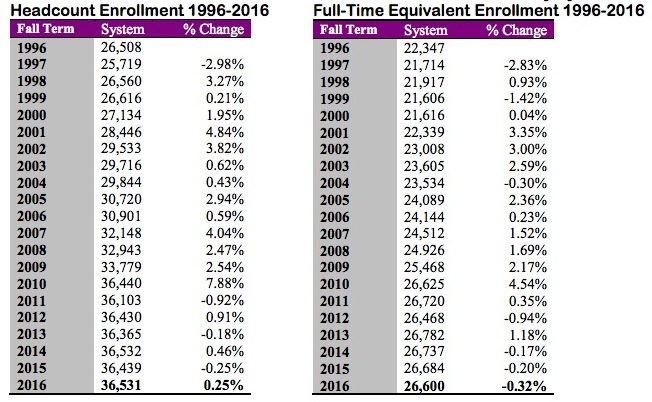Can the press not read? The Board of Regents press release says, “Fall Headcount Grows Slightly at Public Universities.” The AP headline scrolling across the Web is “Fall Enrollment Flat at South Dakota Public Universities.”
Systemwide, South Dakota’s six public universities gained 92 students over last year’s count, up 0.25% to 36,531. However, count up credits and divide by 15 for undergrads, 12 for grad students, 15 for law students, and 19 for med students, and the full-time equivalent student count drops by 84.1, a 0.32% decrease to 26.599.7 FTE.
NSU and DSU both broke 1% headcount growth: NSU netted 91 new bodies on campus for 2.60% growth, while DSU netted 45 for 1.43% growth. Only BHSU saw headcount shrink, which canceled out the gains at NSU, DSU, and Mines by losing 151 bodies, a 3.44% decline (which I don’t get—do you high school graduates not know how beautiful Spearfish is?).
Interestingly, NSU coupled the highest headcount gain with the largest credit-FTE loss by percentage. NSU lost 41.8 FTEs, a 2.10% decline. DSU was the only FTE gainer, adding 37.8 credit FTEs, a 2.03% gain.
If we divide credit FTEs by headcount, we get a picture of which campuses’ students take more credits:
| Institution | FY2015 FTE/headcount | FY2016 FTE/headcount | change (percentage points) |
| BHSU | 65.59% | 66.56% | 0.98 |
| DSU | 59.11% | 59.46% | 0.35 |
| NSU | 57.07% | 54.46% | -2.61 |
| SDSM&T | 84.58% | 83.74% | -0.84 |
| SDSU | 80.56% | 80.31% | -0.24 |
| USD | 74.23% | 73.72% | -0.50 |
| System | 73.23% | 72.81% | -0.41 |
Predictably, the Hardrockers take the most credits per student. The Jackrabbits and the Coyotes have the next highest credit FTE/headcount ratios. Mines, SDSU, and USD are above the systemwide average, suggesting they have a higher proportion of students taking a full load of classes. Among our smaller universities, the Yellow Jackets appear to take a few more credits than their Trojan and Wolf counterparts.
This year’s slight systemwide changes fit a six-year flatline:

Would I be correct in saying enrollment plateaus during recessions and roughly stays there until the next recession and then plateaus at a new slightly higher level?
From a national (AP) perspective, SD has relatively so few students that a 1% increase in SD enrollment is roughly equivalent to the economic impact of a 0.05% increase in enrollment at a university on either coasts. We also do not pull nearly as many students per capita in from out of state.
What’s blowing me away, lately, is the fact that the avg 4 year degree – across the country – is not paying for itself with quality employment opportunities. Just as quickly as this country recognizes an intelligent and capable young adult, we enslave them with unprecedented college debt and run them ragged trying to pay it off.
I watched a movie recently that pointed out how Finland became the education leader in the world today. Apparently, they did away with homework, standardized tests, multiple choice testing and reduced the school day down to 4 hours. The weirdest part: they claim that research from the U.S. is what led them make changes like this – and now they lead the world in smart people production.
Nick, with a slight word correction, I think you’ve got it. Enrollment spikes when recessions hit, then plateau. Such is the pattern over the last 20 years. Does any one have some old Regental Fact Books from the 1970s and 1980s that would show us whether the trend extends farther back?
I check the BOR Enrollment Dashboard and find that at SDSU, USD, and Mines, the ratio of full-time to part-time students is 2.17. At BHSU, NSU, and DSU together, that ratio is 0.85; in other words, our three smaller schools have more part-timers than full-timers.
Four hours in school a day, Adam? What do they do with the rest of their day, play football? ;-)
If ignorance (as espoused by wingnuts) is bliss, then smart people won’t be happy. Dismantling public education in America sure makes wingnuts happy.
We are graduating a student this year in Physics who did an internship at Boeing over the summer. They are going to hire him after this semester, AND pay for his graduate school. Sounds like a quality employment opportunity to me!
While we do not require things like internships and undergraduate research projects, we certainly encourage them in Physics. The Minor in Nuclear Engineering does require either an internship or a research project in an area of nuclear science/engineering.
Is there a connection to State Governments emphasis on increasing enrollment in Vocational Technical Schools and minimizing the need for college education. From a weaker perspective than Nicks, I don’t see near the emphasis from parents, local institutions, or even government for students,(even those of average academic skills) to go to college? Is the GI bill being fully used by exiting military to secure advanced education? Just some more variables to think about.
Cory, yeah, only 4 hours/day, and they really think they’ve proven that, “letting kids be kids” allows kids to focus harder and better on school when it’s in session.
They assert that making kids slave away for most of thier day actually impedes the learning process.
Crazy right?! Or smart? All I know is they used to be right on par with the U.S. and now they kick our ass in education by doing things very very different. It almost blows me away.